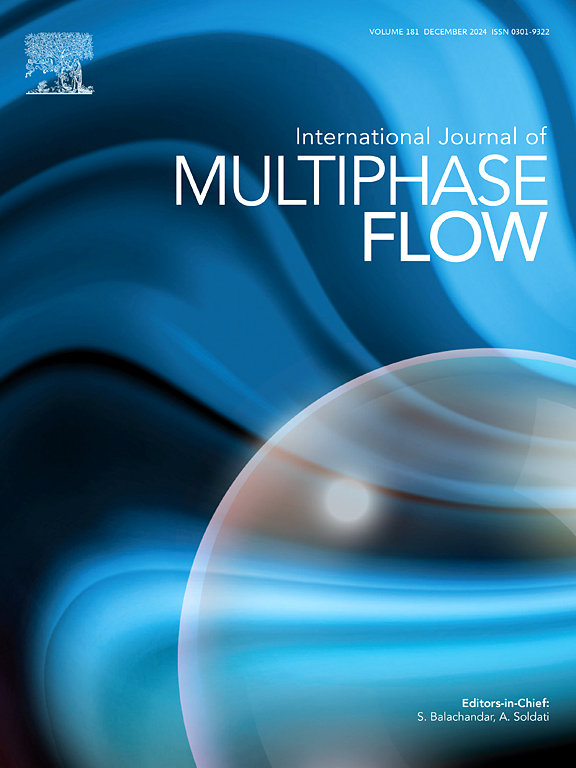Displacement flow inside a capillary tube — the impact of boundary conditions on the dynamic contact angle
IF 3.8
2区 工程技术
Q1 MECHANICS
International Journal of Multiphase Flow
Pub Date : 2025-07-15
DOI:10.1016/j.ijmultiphaseflow.2025.105338
引用次数: 0
Abstract
Accurately modelling multiphase flows requires a thorough understanding of advancing contact line behaviour, which is crucial for predicting interface dynamics in applications like microfluidics and coating processes. This research investigates how the contact angle boundary condition and slip length influence the dynamic contact angle and interface shape within a horizontal cylindrical capillary tube at low velocities. We conduct numerical simulations of Newtonian fluid flow using the volume of fluid (VOF) method to analyse the impact of these factors across different length scales. We explore three approaches for specifying the contact angle at the triple line, comparing velocity-dependent and velocity-independent models. Our results indicate that employing a velocity-dependent relation reduces the critical capillary number for air entrainment and overestimates the apparent contact angle compared to Hoffman’s experimental findings. Imposing a contact angle based on Kistler’s relation enlarges the viscous bending zone compared to the constant contact angle model. Additionally, increasing slip length influences the apparent contact angle differently depending on the contact angle model used. The best agreement with experimental data is achieved using a constant quasi-static advancing contact angle in the low to intermediate capillary number range. A detailed analysis of the interface shape highlights the role of slip length in regulating viscous bending extent. These findings offer valuable insights for enhancing the accuracy of numerical simulations of multiphase flows involving contact lines, with significant implications for practical applications.

毛细管内的位移流动——边界条件对动态接触角的影响
准确建模多相流需要对推进接触线行为有透彻的了解,这对于预测微流体和涂层工艺等应用中的界面动力学至关重要。研究了接触角边界条件和滑移长度对水平圆柱毛细管低速动态接触角和界面形状的影响。我们使用流体体积(VOF)方法对牛顿流体流动进行数值模拟,分析这些因素在不同长度尺度上的影响。我们探讨了三种方法来指定接触角在三线,比较速度依赖和速度无关的模型。我们的结果表明,与霍夫曼的实验结果相比,采用速度相关关系降低了空气夹带的临界毛细管数,并高估了表观接触角。与恒定接触角模型相比,施加基于Kistler关系的接触角增大了粘性弯曲区。此外,根据所使用的接触角模型的不同,增加滑移长度对表观接触角的影响也不同。在低至中等毛细数范围内,采用恒定的准静态推进接触角,得到了与实验数据最一致的结果。对界面形状的详细分析强调了滑移长度对粘性弯曲程度的调节作用。这些发现为提高涉及接触线的多相流数值模拟的准确性提供了有价值的见解,对实际应用具有重要意义。
本文章由计算机程序翻译,如有差异,请以英文原文为准。
求助全文
约1分钟内获得全文
求助全文
来源期刊
CiteScore
7.30
自引率
10.50%
发文量
244
审稿时长
4 months
期刊介绍:
The International Journal of Multiphase Flow publishes analytical, numerical and experimental articles of lasting interest. The scope of the journal includes all aspects of mass, momentum and energy exchange phenomena among different phases such as occur in disperse flows, gas–liquid and liquid–liquid flows, flows in porous media, boiling, granular flows and others.
The journal publishes full papers, brief communications and conference announcements.

 求助内容:
求助内容: 应助结果提醒方式:
应助结果提醒方式:


